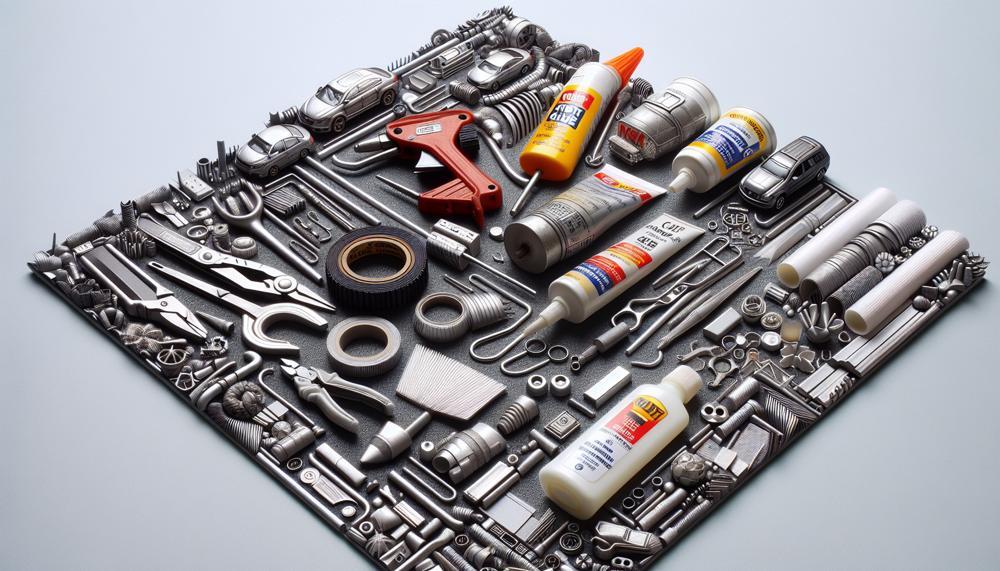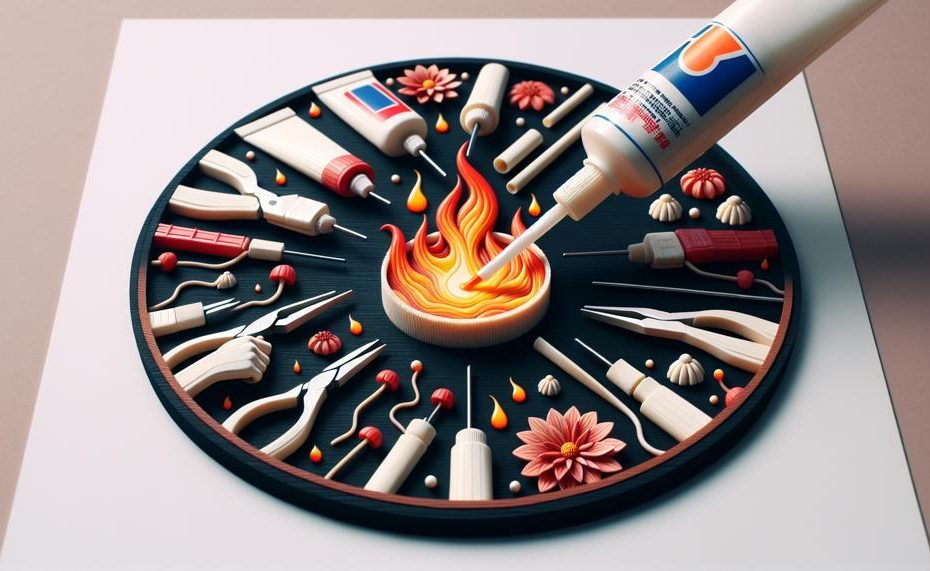We all know the miraculous powers of hot glue when it comes to creating stunning and sturdy projects. But have you ever encountered a material that simply refuses to bond with this trusty adhesive? Fear not, my fellow creators, for you are not alone. In fact, there are several materials that hot glue just can’t seem to stick to. So let’s delve into the world of crafting and explore some of the most common materials that hot glue won’t adhere to.
Plastic, oh plastic. This versatile material is used in so many everyday objects, from toys to containers. Yet, it poses a challenge for hot glue as it tends to peel off easily, leaving your project in shambles.
Next up on the list is glass. While initially hot glue may cling onto its smooth surface, it often becomes brittle and breaks off with ease. And let’s be real, no one wants their carefully crafted masterpiece falling apart due to a weak bond.
Metal presents a similar issue as glass with its slick surface making it difficult for hot glue to hold on for long periods of time. It may seem like a suitable option at first but don’t be fooled by its initial grip.
And then there’s fabric. Depending on the type of fabric, hot glue may not provide enough strength to withstand wear and tear. So if you’re planning on using this adhesive for your sewing projects, think again.
There are plenty of other adhesive options out there for these materials.
So keep reading as we dive into alternative solutions for all your crafting needs.
Table of Contents
What Can Hot Glue Stick To?
Hot glue is a versatile adhesive that can bond a wide range of materials together, making it a go-to choice for various applications. From wood and paper to ceramics and fabrics, hot glue has the capability to create strong bonds between different types of materials.
However, as with any adhesive, there are certain factors to consider when using hot glue.
For starters, hot glue is a thermoplastic adhesive, meaning it needs heat to melt and form a bond. Therefore, it is crucial to ensure that the materials being bonded can withstand high temperatures without being damaged.
Additionally, hot glue works best on porous surfaces, as it needs some texture or roughness to adhere properly.
This means that non-porous materials such as glass, metal, and certain types of plastic may not provide enough surface area for the adhesive to bond effectively.
Materials Not Compatible With Hot Glue
When it comes to using hot glue for your projects, it’s important to keep in mind that not all materials are compatible with this popular adhesive.
Due to their smooth or non-porous surfaces, as well as chemical properties that prevent a strong bond, certain materials may not work well with hot glue. These materials include plastic, rubber, metal, oil, moisture, dirt, and oil-based substances like petroleum jelly or vegetable oil.
Additionally, porous materials like fabric or wood may not be suitable for hot glue as it can easily soak in and not create a strong adhesive bond. Even high-strength applications such as gluing stones, rocks, granite, or steel together may not be suitable for hot glue.
To help you better understand which materials are not compatible with hot glue, here is a table listing some common examples:
| Material | Reason for Incompatibility |
| Plastic | Hot glue does not bond well with smooth or non-porous surfaces. |
| Rubber | Similar to plastic, hot glue does not create a strong bond with rubber surfaces. |
| Metal | The smooth surface of metal does not provide enough texture for hot glue to adhere to. |
| Oil | Hot glue does not bond well with oily surfaces as it cannot penetrate through the oil to create a strong bond. |
| Moisture | Water-based hot glue may not work well on wet surfaces as it can weaken the adhesive bond. |
| Dirt | Hot glue cannot bond well with dirty surfaces as the dirt may prevent it from adhering properly. |
| Oil-based substances (petroleum jelly, vegetable oil, etc.) | The chemical properties of these substances prevent hot glue from bonding effectively. |
| Porous materials (fabric, wood, etc.) | Hot glue can easily soak into porous materials, making it difficult to create a strong adhesive bond. |
| Smooth surfaces (metal, silicone, vinyl, wax, etc.) | The smooth surface of these materials does not provide enough texture for hot glue to adhere to. |
| High-strength applications (stones, rocks, granite, steel, etc.) | Hot glue may not be strong enough to create a lasting bond on heavy or high-strength materials. |
As you can see from this table, there are many materials that are not compatible with hot glue.
Different Types Of Glue
There are various kinds of glue that are not compatible with hot glue, such as water-based glue, solvent-based glue, epoxy glue, low melting point adhesives, and non-heat resistant glues. Using these types of glue with hot glue can result in weak bonding or even damage. Therefore, it is crucial to select the appropriate type of adhesive to achieve a robust and long-lasting bond when using hot glue.
When it comes to choosing the right type of glue for your project, it’s important to consider factors such as the materials you are working with and the desired strength of the bond.
For example, water-based glue is not suitable for use with hot glue as it can cause the bond to weaken over time. Similarly, solvent-based glue is not recommended as it can react negatively with hot glue and lead to poor adhesion.
Epoxy glue, on the other hand, is a popular choice for bonding materials that require a strong and durable bond. However, it is not recommended for use with hot glue as it can react with the heat and cause the bond to fail. Low melting point adhesives are also unsuitable for use with hot glue as they can melt under high temperatures, compromising the bond between materials.
Lastly, non-heat resistant glues should be avoided when working with hot glue. These types of glue cannot withstand high temperatures and can cause the bond to weaken or fail altogether.
By choosing the right type of adhesive for your project, you can ensure a strong and lasting bond when using hot glue.
Metals
Hot glue is a versatile adhesive that has proven its worth in various applications. However, it does have limitations when it comes to bonding with certain metals. The general rule is that hot glue does not adhere well to smooth and non-porous surfaces, which includes most metals. However, there are specific types of metals that hot glue may not stick to at all, such as aluminum, stainless steel, copper, brass, and galvanized metal.
Moreover, it’s important to note that hot glue may struggle to bond with metals that are coated with oil or wax. The presence of these substances can prevent proper adhesion between the glue and the metal surface. This is especially true for metal surfaces used for cooking or those that have been polished with oil or wax.
While hot glue may still work on some types of metal, it may not be as strong or long-lasting as other types of adhesive. For best results, it’s always recommended to test the hot glue on a small area first before using it on a project involving metal.
| Metal Type | Hot Glue Adhesion |
| Aluminum | Poor |
| Stainless Steel | Poor |
| Copper | Poor |
| Brass | Poor |
| Galvanized Metal | Poor |
Glass
While it is possible to use hot glue to stick items to glass surfaces, it may not always provide the strongest bond. It is important to exercise caution when handling hot glue guns and to use low-temperature hot glue for delicate or valuable items to prevent damage.
Using hot glue on glass surfaces requires specific techniques and precautions for optimal results. Here are some useful tips and guidelines for using hot glue on glass:

| Tip | Guideline |
| Preparation | Before applying hot glue, make sure to thoroughly clean the glass surface with rubbing alcohol or glass cleaner to remove any dirt, dust, or oils. This will help ensure a strong bond. |
| Type of Hot Glue | For delicate or valuable items, it is recommended to use low-temperature hot glue to prevent damage. For regular items, high-temperature hot glue can be used. |
| Application | To apply hot glue, spread a thin layer onto the glass surface and firmly press the item onto the glue. Hold it in place until the glue cools and sets completely. |
| Curing Time | While hot glue usually dries and sets within a few minutes, for a stronger bond it is best to let it cure for at least 24 hours before handling the item. |
| Removing Hot Glue | If you need to remove hot glue from a glass surface, you can use a heat gun or hairdryer to soften the glue and gently scrape it off with a plastic scraper. Be sure to avoid using sharp tools that could scratch the glass. |
Overall, while hot glue can be used to stick items to glass surfaces, it is crucial to take necessary precautions and use the appropriate type of hot glue for the best results.
Ceramics
When it comes to creating beautiful and functional pieces like pottery, ceramic tiles, and figurines, ceramics are a popular choice. However, not all types of ceramics can withstand the heat from hot glue. In this section, we will explore the different types of ceramics that are not suitable for hot glue and why.
Porcelain and glass ceramics are two types of ceramics that should not be used with hot glue. These materials are delicate and sensitive to heat, making them prone to cracking or shattering when exposed to high temperatures. The use of hot glue on these fragile materials can result in melting or breakage, leading to a failed repair or even damaging the original piece.
Similarly, delicate pottery such as fine china or ceramic figurines should not be repaired with hot glue either. The heat from the glue can cause these fragile pieces to crack or break, ruining the repair and potentially causing irreparable damage.
While some ceramics are designed to withstand high temperatures, using hot glue on them is still not recommended. Ceramics used for cooking or in industrial settings are typically made with special glazes and firing techniques that make them resistant to heat. However, hot glue can melt or damage the surface of these high-temperature ceramics, rendering them unsuitable for repairs.
Greasy Or Oily Surfaces
When it comes to hot glue, it can be a struggle to get it to properly adhere to certain materials that are coated in oils or greases. This includes a variety of surfaces such as metal, plastic, rubber, and some types of fabrics like polyester or rayon. These surfaces often have oils or additives that create a barrier between the hot glue and the surface, preventing it from bonding effectively. To ensure a strong bond with hot glue, it’s important to properly clean and prepare these greasy or oily surfaces beforehand.
One common type of metal that can be difficult for hot glue to stick to is aluminum. This is because aluminum is often coated with oils or lubricants used in the manufacturing process.
Similarly, plastics such as polypropylene and polyethylene can also pose challenges for hot glue due to their slick surface caused by additives or fabric softeners. Natural rubber is another material that can cause issues as it often contains oils that prevent hot glue from adhering properly.
When dealing with greasy or oily surfaces, it’s important to use a suitable cleaning agent that can cut through the oils and remove any residue. This will help create a clean surface for the hot glue to bond to, ensuring a strong hold. Additionally, it may be helpful to roughen up the surface slightly with sandpaper to provide more texture for the hot glue to adhere to.
| Aluminum | Polypropylene | Natural Rubber |
| Stainless Steel | Polyethylene | |
| Copper | ||
| Common sources of grease: cooking oils, machine lubricants | Common sources of oils: additives, fabric softeners, detergents |
Plastic And Rubber
Hot melt glue is a versatile adhesive that can bond with various types of plastic and rubber materials. However, it’s essential to note that proper preparation and technique are necessary for achieving strong bonds with certain materials.
When it comes to plastic materials like PVC, acrylics, and polycarbonates, minimal surface preparation is needed as long as the surfaces are clean and dry. To ensure a reliable bond, it’s best to use a hot glue gun with a precision nozzle, such as the Rapid CG270, EG280, or EG320 models. These nozzles allow for precise application and can be particularly useful for intricate projects.
However, bonding with materials like polypropylene and natural rubber may be more challenging due to the presence of oils and additives. In these cases, it’s crucial to properly clean and degrease the surfaces before applying hot glue. Additionally, using a precision nozzle and sanding down the surface can help improve adhesion.
When working with rubber materials like silicone and EPDM rubber, no surface preparation is typically needed. As long as the surfaces are clean and dry, hot glue can provide a strong bond. However, sanding down the surface may improve adhesion for EPDM rubber.
Overall, utilizing a hot glue gun with a precision nozzle is the best way to ensure strong bonds across various types of plastic and rubber materials.
| Plastic Material | Recommended Hot Glue Gun | Additional Tips |
| PVC | Rapid CG270 | Strong bonds can be achieved with clean and dry surfaces without any preparation. |
| Acrylics | Rapid EG280 or EG320 | Sanding the surface can enhance adhesion. Precision nozzles work best for intricate projects. |
| Polycarbonates | Rapid EG320 | For clean and dry surfaces, no preparation is needed to achieve a strong bond. |
| Polypropylene | Rapid EG280 or EG320 | For the best results, clean and degrease the surface before application. Precision nozzles work best. |
| Natural Rubber | Rapid CG270 or EG280 | Before applying hot glue, make sure to clean and degrease the surface. Precision nozzles provide better results. |
| Silicone Rubber | Rapid EG320 | Achieve a strong bond with clean and dry surfaces without any preparation. |
Other Factors To Consider
In addition to the type of material being used, there are several other factors that can impact the effectiveness of hot glue. These factors include temperature, surface texture, pressure, and environmental conditions like humidity and air flow. It’s crucial to take these factors into account when working with hot glue to achieve the best and most durable results.
Furthermore, the temperature of the environment can greatly affect the bonding strength of hot glue. In higher temperatures, hot glue tends to dry faster and have a stronger hold, while in cooler temperatures, it may take longer for the glue to set and may result in a weaker bond. It’s also important to consider the surface texture of the materials being glued together. Rough or uneven surfaces may not allow for proper adhesion, leading to a weaker bond.
Another factor to keep in mind is the amount of pressure applied when using hot glue. Applying too much pressure can cause the glue to spread too thin, resulting in a weaker bond. On the other hand, not applying enough pressure can leave gaps between the materials, also compromising the strength of the bond.
Environmental conditions such as humidity and air flow can also play a role in the effectiveness of hot glue. High humidity levels can slow down the drying process, while strong air flow can cause the glue to cool and set too quickly, affecting its bonding strength.
Also Read: Is Hot Glue Conductive?
Conclusion
In conclusion, hot glue may be a go-to adhesive for many crafting and DIY projects, but it does have its limitations. Despite its strength and versatility, there are certain materials that hot glue simply cannot stick to. These include plastic, glass, metal, and some types of fabric.
However, with careful preparation and consideration of factors such as material compatibility and environmental conditions, hot glue can still provide strong bonds for a wide range of materials.
It’s important to keep in mind the unique properties of hot glue when using it for different materials. While it may work well on paper or wood, it may not be the best choice for bonding plastic or metal. This is where exploring alternative adhesive options can come in handy.






